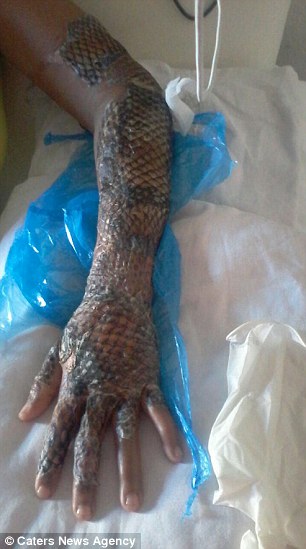The revolutionary method developed in Brazil to treat severe burns with tilapia skin

- Maria Ines Candido da Silva, 36, suffered severe burns from an explosion
- She has been given Tilapia fish skin in a new treatment to reduce her injuries
- It’s believed to be the first time scientists have used fish skin to treat wounds
- Experts say its skin is disease-resistant, reduces infection and acts like a plaster
A 36-year-old woman who had suffered severe burns has been given fish skin to reduce her injuries in pioneering new treatment.
Maria Ines Candido da Silva, 36, worked as a waitress at a restaurant in Russas, north east Brazil.
An explosion from a gas canister at the restaurant she was working at caused severe burns to her arms, neck and some of her face.
Doctors offered her an alternative treatment – to dress her wounds with the skin of a common freshwater fish.
It’s believed to be the first time in medical history that scientists have used the skin of a fish as a plaster to treat wounds.
‘I was in absolute agony and desperate for anything to ease my suffering,’ Miss da Silva told The Sun.

And the first trials on some 50 patients were completed this month.
They used the skin from Tilapia fish, a disease-resistant species found in Brazilian rivers.
Before the fish strips are used, researchers put the skin through a rigorous process that removes scales, muscle tissue, toxins and any possibility of transmitted diseases. It also gets rid of the fishy smell.
The fish skin reduces the risk of infection – and it’s cheaper to work with, experts say.
It is stretched and laminated then stored in refrigerated banks based in Sao Paulo, in strips of 10cm by 20cm for up to two years.
The result is something similar to human skin and remains flexible and easy to mould around a wound.
The Tilapia’s skin was left on Miss da Silva’s neck, face and left arm for 11 days before being removed.
Doctors kept the fish skin on her left hand for longer as these wounds were deeper.
The fish skin grafts on her hand were replaced many times over a 20 day period to restore the damaged tissue.
Then, doctors removed the scaly skin using petroleum jelly to lift, slide and ease the dressing away from the healed area.
According to Dr Edmar Maciel, one of the plastic surgeons who developed the treatment, Tilapia skin contains ‘optimum levels of collagen type one’ and high degrees of humidity, so it takes a long time to dry out.
These are important characteristics known for healing burns and for providing patients with essential proteins.
Miss da Silva was one of the first patients to be treated with the Tilapia fish skin treatment in October this year.
She said that the skin felt futuristic as if it was from a ‘sci-fi movie’.
Dr Edmar Maciel also told the newspaper: ‘We discovered that Tilapia fish skin performs significantly better in the healing process by soothing and curing severe wounds caused by burns.’
Source : Dailymail
